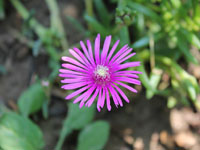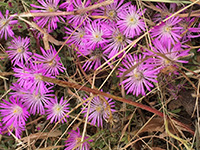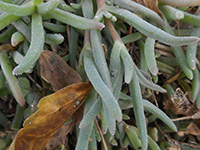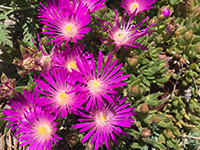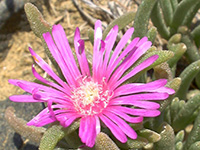![]()
Cooper's Iceplant is a dwarf perennial plant, native to South Africa, that forms a dense lawn with abundant, long-lasting flowers. The flowers are the most brilliant aspect of this plant, with the production of a great quantity of vermillion, magenta or pink flowers that will often cover an entire growing area, hence the popular name "pink carpet". The common name 'iceplant' is derived from the appearance of what looks like sparkling glass beads, or ice crystals, that is caused by bladder-like hairs on the leaf surface that reflect and refract light in a manner to make it appear that they sparkle.
![]()
There is currently no commercial applications for cooper's iceplant.
![]() Within the realm of rational and holistic medicine, there is currently no known uses for cooper's iceplant.
Within the realm of rational and holistic medicine, there is currently no known uses for cooper's iceplant.
Please note that MIROFOSS does not suggest in any way that plants should be used in place of proper medical and psychological care. This information is provided here as a reference only.
![]()
There currently is no information on the edibility of cooper's iceplant.
Please note that MIROFOSS can not take any responsibility for any adverse effects from the consumption of plant species which are found in the wild. This information is provided here as a reference only.
![]()
Cooper's Iceplant is suitable for light (sandy) and medium (loamy) soils, and prefers well-drained soil. Cooper's iceplant is suitable for mildly acidic and neutral soils. It can grow in semi-shade (light woodland) or no shade. It prefers moist and well drained soil. It can be cultivated in a wide range of areas with a Mediterranean climate. Unlike many ice plants, this species is hardy to -29°C. The leaves turn red in cold winter temperatures. Due to the low need for maintenance, it is suitable for urban environments and high temperature regions. It can often be found in large, extensive patches. The trailing stems also make it suitable for flowerpots and terraces.
| Soil Conditions | |
| Soil Moisture | |
| Sunlight | |
| Notes: |
![]()
The plant contains ramified stems that are spread out and are long and narrow, with the end of the stems increasing into a quantity of isolated small flowers, with diameters ranging from 3cm to 5cm. These abundant and long-lasting flowers will remain in bloom from July through September. The plant is sun-loving, and thrives well in very dry and hot environments. While it adapts well to various soil types, it will suffer under water stagnation, and thus prefers well drained soils, or even rocky terrain. The flowers of cooper's iceplant are violet to pink with many ray like pedals. Cooper's Iceplant reproduces by seed or by plant cuttings.
![]()
| Plant Height | 10cm to 15cm | 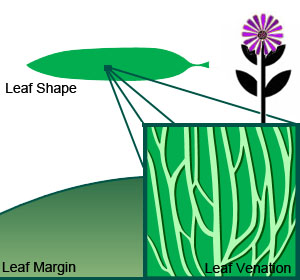 |
| Habitat | Roadsides, Clearings, Lawns, Rocky Areas | |
| Leaves | 1cm to 5cm long, Linear | |
| Leaf Margin | Entire | |
| Leaf Venation | Longitudinal | |
| Stems | Hairy Stems | |
| Flowering Season | July to October | |
| Flower Type | Medium sized ray flowers | |
| Flower Colour | Violet to Pink | |
| Pollination | insect | |
| Flower Gender | Flowers are hermaphrodite and the plants are self-fertile | |
| Fruit | Hard seed pods | |
| USDA Zone | 5A (-26°C to -28°C) cold weather limit |
![]()
No known health risks have been associated with cooper's iceplant. However ingestion of naturally occurring plants without proper identification is not recommended.
![]()
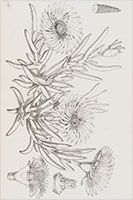 |
-Click here- or on the thumbnail image to see an artist rendering, from Kew Gardens, of Cooper's Iceplant. (This image will open in a new browser tab) |
![]()
 |
-Click here- or on the thumbnail image to see a magnified view, from an unknown source, of the seeds created by Cooper's Iceplant for propagation. (This image will open in a new browser tab) |
![]()
Cooper's Iceplant can be referenced in certain current and historical texts under the following three names:
Cooper's Iceplant can be translated into the following select languages:
| Arabic | مصنع الثلج | Bulgarian | лед за растителна | Chinese (Sim) | 冰厂 |
| Croatian | led biljke | Czech | led rostlina | Danish | |
| Dutch | Esperanto | glacio planto | Estonian | jää taim | |
| Finnish | French | fabrique de glace | German | Mittagsblume | |
| Greek | εργοστάσιο πάγου | Hebrew | מפעל קרח | Hungarian | jég növény |
| Italian | impianto di ghiaccio | Japanese | アイスプラント | Korean | 얼음 공장 |
| Punjabi | ਆਈਸ ਪੌਦਾ | Lithuanian | ledo gamykla | Norwegian | |
| Persian | کارخانه یخساز | Polish | Portuguese | fábrica de gelo | |
| Romanian | plantă de gheață | Russian | лед завода | Slovak | ľad rastlina |
| Spanish | planta de hielo | Swedish | is växt | Tagalog | |
| Turkish | buz çiçeği | Ukrainian | лід заводу | Vietnamese | nhà máy nước đá |

![]()
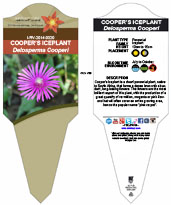 |
The MIROFOSS database offers free printable garden tags for personal and non-profit use. These tags can be used to properly identify plant samples in a garden. Click on the tags shown on the the screen or -click here- to download a full size jpeg image for a cooper's iceplant identification tag; which can be printed on paper or used with a plastic laser printer. |
 |
What's this? What can I do with it? |
![]()
| Description | Leistner, O. A. (ed.). 2000. Seed plants of southern Africa: families and genera. Strelitzia 10. National Botanical Institute, |
| Description | Smith, G. F.; Chesselet, P.; Van Jaarsveld, E. J.; Hartmann, H.; Hammer, S.; Van Wyk, B.-E.; Burgoyne, P.; Klak, C.; & Kurzweil, H. 1998. Mesembs of the world. Briza Publications, |
| Image Rendering | USDA-NRCS PLANTS Database / USDA NRCS. Wetland flora: Field office illustrated guide to plant species. USDA Natural Resources Conservation Service. |
| Image Rendering | USDA-NRCS PLANTS Database / USDA NRCS. Wetland flora: Field office illustrated guide to plant species. USDA Natural Resources Conservation Service. |
| Environment | National Audubon Society. Field Guide To Wildflowers (Eastern Region): Alfred A. Knopf. ISBN 0-375-40232-2 |
| Physical Identification | National Audubon Society. Field Guide To Wildflowers (Eastern Region): Alfred A. Knopf. ISBN 0-375-40232-2 |
| June 06, 2015 | The last time this page was updated |
| ©2025 MIROFOSS™ Foundation | |
 |
|

